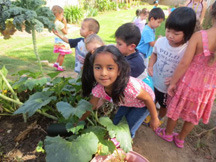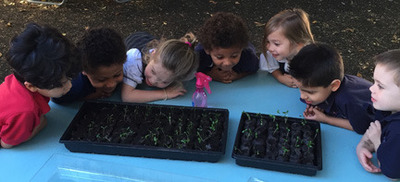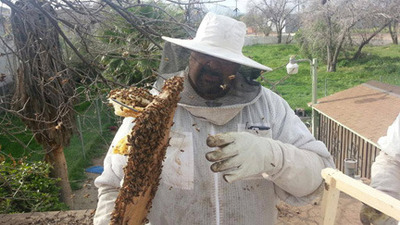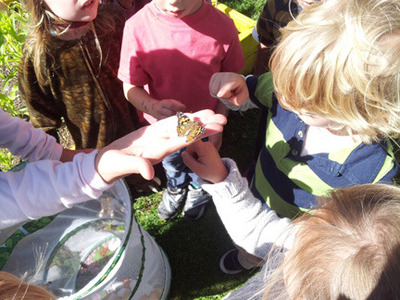Bees, butterflies, boats, and beds and barrels on wheels are just some of the ways Southland Episcopalians are optimizing space and caring for creation.
Inspired by Bishop J. Jon Bruno’s call to environmental and food justice, most of the diocese’s schools and churches are engaged in acts of green, many of them via Seeds of Hope, a Hands in Healing ministry of the Diocese of Los Angeles.
“When Bishop Jon said ‘this is who we are and what we’re doing,’ people listened,” according to Tim Alderson, Seeds of Hope executive director.
In the two years since, the ministry has exploded. Today a staff of eight, funded by government grants, assist diocesan congregations, schools and institutions in developing new gardens or expanding existing ones, in optimizing space for acts of green, as well as teaching health and nutrition classes, often with amazing results.
“When you start to experience what it’s like to bring food out of the ground, it’s miraculous,” Alderson said. “The church grounds can give life to the community in the truest, most literal sense of that word. It’s transformative.”
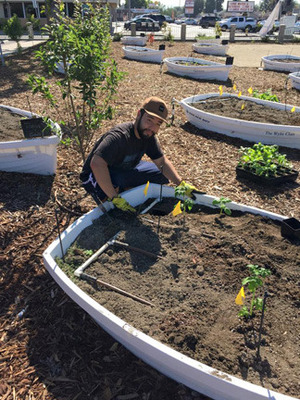 The ‘boat church’ in Fullerton
The ‘boat church’ in Fullerton
St. Andrew’s Church in Fullerton is using boats to help feed the hungry.
Tomatoes, eggplant, squash, broccoli, cabbage, lettuce, carrots, radishes sprout from fifty 8 x 5-foot fiberglass dinghies on St. Andrew’s former front lawn, and all of it is donated to local food banks, according to the Rev. Beth Kelly, rector.
The idea for the boat garden was a natural “because Andrew was called by Jesus from a boat,” say Kelly and volunteer Roger Yule. “And because St. Andrew was a fisherman and it makes us closer to who we are, and because it’s meant to provide food for people who can’t afford it,” Yule added.
Once the garden idea was conceived about two years ago, details fell into place. SoCal WaterSmart helped defray the cost of replacing the lawn with a water efficient irrigation system.
Landscape architect and former parishioner Mark Rios designed the garden pro bono; the boats were donated, arriving stacked on top of each other. Holes were drilled in the bottoms to allow for irrigation; they were filled with soil and planted.
“We dug the holes for the boats to go in and the dirt was like concrete,” recalled Yule, 83. “We cut out these holes maybe six inches deep to put the boats in and make it look like they were floating on the ground. It’s been quite an experience.”
The boats are aligned toward a central table used during garden work days and that doubles as an altar during the parish’s annual harvest festival, Kelly said.
Teams of church and community volunteers help maintain the garden, including agriculture students from nearby Cal State Fullerton. St. Andrew’s has become known as “the boat church,” even attracting new members because of it, Kelly said.
Volunteer team captain Jessi Lowerre, 27, said she sings as she weeds, waters, harvests. She and Kelly say it has taught them about abundance and God’s bountiful creation and has taught the surrounding neighborhood more about St. Andrew’s.
“The abundance of it is amazing. I cannot pick enough lettuce. You really feel like you’re participating with God,” Kelly said.
It has expanded Lowerre’s community of faith to the plants in the garden. “I relate to them as living beings that I’m helping to raise up in service to God and to our community,” she said. “I’ve created a relationship with more living creatures around me and that grounds me in my faith and existence in the world.”
She especially likes the message she believes the garden sends to the community, that “this is who we are, and we love our town of Fullerton. We want to give back. We want to be involved with you and we want you to be involved with us. All are welcome. Everyone is welcome. Just come be in the garden, experience it. It’s open to everyone.”
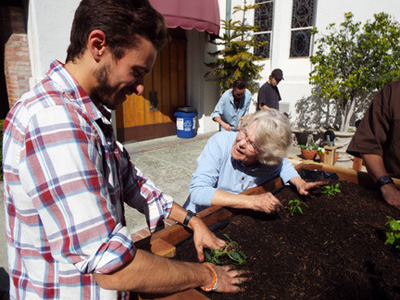 Rolling, growing in Long Beach
Rolling, growing in Long Beach
With a Seeds of Hope consultation a few months ago, St. Luke’s Church in Long Beach came up with rolling beds and barrels-on-wheels.
Located in a food desert with “no resources and no space,” but a strong desire to feed local poor, “we discovered that with mobile beds, we could tuck them into corners and see what we could grow,” said the Rev. Steve Alder, St. Luke’s deacon.
And grow they have, yielding in a few months enough Swiss chard and red lettuce to supplement biweekly Manna Meals, an outreach feeding program for the homeless.
Parishioner Penny Conroe showed up with a pair of gloves and a whole lot of enthusiasm at the initial workday. Seeds of Hope brought knowledge, materials and interns to help build wooden beds and barrels on wheels.
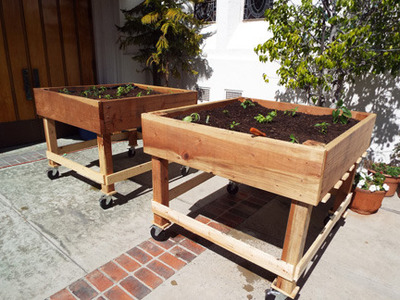 Conroe’s enthusiasm has grown exponentially. “I got to run the chop saw — it was great! I’d never done anything like that at a church before.
Conroe’s enthusiasm has grown exponentially. “I got to run the chop saw — it was great! I’d never done anything like that at a church before.
“Anytime you can work with somebody, put on a pair of gloves and do something tangible, that you can sit back and see the results, you know people in a way you probably would never have known them otherwise,” Conroe said.
Additionally, the new beds, which are rearranged to catch and avoid the sun as needed, have also raised St. Luke’s visibility — not just about the vegetables but also about exercise and nutrition classes and the church’s food justice ministry, according to the Rev. Canon Gary Commins, rector.
“For us, that’s been important in terms of raising the visibility of our food justice efforts,” he said. “I see it as part of the process” which continues to unfold and now includes plans for a capital campaign and installation of a commercial kitchen.
“It’s wonderful, that in a place where it’s mostly cement, we still can grow fresh produce,” Alder added.
“Carrots, peas and broccoli, vegetables are good for me,” sing preschoolers at St. Mark’s Episcopal School during an outdoor lesson at their garden.
“We talk about healthy eating right from the start,” says teacher Fran Kavoosi. “Kids need to be in touch with the earth. We plan together; we prepare the soil. They see that seeds go into the ground, and then plants come. We water, remove weeds, we tell them they’re helping the plants to grow and they’re helping to care for the earth.”
 The results are huge: zucchini that is washed and sliced and transformed into bread in a cooking class; five-foot stalks of kale whose leaves, along with bananas and blueberries, become smoothies “with no sugar, and that the children adore,” Kavoosi said.
The results are huge: zucchini that is washed and sliced and transformed into bread in a cooking class; five-foot stalks of kale whose leaves, along with bananas and blueberries, become smoothies “with no sugar, and that the children adore,” Kavoosi said.
Teacher Violeta Robbins said efforts to wean students away from sugary snacks, processed foods and frozen meals at an early age have caught on with some parents, who have begun home gardens.
“Little by little, the idea is growing on them, too.”
Interim preschool director Carmen de la Fuente said the garden also rounds out students’ spirituality, teaching them how to care, not just for one another but also for the environment.
“They go from the abstract to the concrete,” de la Fuente said. “They plant, they visit the garden, they water, they learn to nurture. They learn to understand, to care. It encompasses the spiritual aspect of gratitude, the thankfulness of realizing something from nothing, of seeing vegetables grown and put on the table. It’s a way of seeing the power and gift nature can give us.”
Similarly, Ami Redman, director of St. George’s Academy Preschool in Laguna Hills, said planting milkweed is part of an eco-friendly curriculum for preschoolers.
A small garden plot that had yielded vegetables and other environmental lessons has now become a milkweed garden, which the students helped to plant and are watching the growth.
Students like Mary, Benjamin and Simone are excited and “can’t wait to see the butterflies.”
Said Redman, “We realized that Monarch butterflies are endangered, and we wanted to find a way to help them and make homes for them.
“We also want to make it fun for the children; they’ll be learning about the butterflies at the same time they see them.”
After some members of St. George’s Church in Riverside learned about the embattled status of California’s honeybees, they created a bee club and incorporated a couple of acres of unused land to create the St. Ambrose Bee Sanctuary.
They acquired a hive and set out to learn about bees and how to help them, according to Diane Askren.
In the process they’ve harvested honey, converted wax into lip balm that was sold at Diocesan Convention, and even contributed to the making of the Paschal candle.
Lighting that candle on Easter morning felt glorious to parishioner Katie Larson, who participated in the process to make it.
To support the efforts, “we’ve made bee gardens around our church so they have something to eat. We just recently put in a meditation garden and all of our plants and trees are bee-friendly,” Askren said.
Aided by local beekeeper Michael Allison, the church’s bees have also gone on loan to help pollinate almond trees in the Central Valley, and will soon split their hive to create more opportunities for bees.
Allison, who donated the first hive to the church and maintains the “Luvabee” Facebook page, said the effort is of maximum importance because honeybees “pollinate about 70 percent of the food we eat,” he said. “We would lose a lot of fruits and vegetables” if the bees are not protected.
“If we lost our bees, if the bees got so decimated to where we cannot pollinate, we will lose denim jeans,” said Allison. “Cotton is pollinated by bees — so, if you like your jeans, ‘luvabee!’”
The St. George’s bee club will offer classes in May and August, and Allison advises that churches considering similar efforts need to find a local beekeeper. And don’t let lack of space be a deterrent, he added. “You don’t need a lot of space — you can do it on rooftops.”
In Hollywood, the St. Stephen’s Church garden is a teaching tool for its Delaney Wright Fine Arts Preschool students; its produce is both donated and has become a business enterprise, according to the Rev. Canon Jaime Edwards-Acton, rector and executive director of the Jubilee Consortium, a Seeds of Hope partner.
Seeds are saved; seedlings cultivated and “right now we have several thousand seedlings in the garden at different stages and ready” for sale, Edwards-Acton told the Episcopal News.
St. Stephen’s seedlings have been used in three recent Seeds of Hope garden plantings and are available for sale to the general public as well, at prices competitive with local retailers. And, while St. Stephen’s garden capacity has recently been expanded, Edwards-Acton is still eying the parking lot and considering creative possibilities to, well, keep growing.
“We’ve got compost going,” he said. “We’ve got worms going. Now we’ve got seedlings going,” as well as exercise and nutrition classes offered through the Jubilee Consortium, a nonprofit agency formed in 2001 to improve the health and well-being of the Los Angeles community.
Maintaining gardens raises awareness he said. “It impacts the way people think about what we eat for coffee hour, about what they’re putting in their body in general, what they’re serving their kids,” Edwards-Acton added. “Fresh, homegrown foods not only look good, but taste good — it creates a lot of questions for people.”
Parishioner and volunteer Tim Parks said tending the garden really brings home the “ashes to ashes and dust to dust” reality of life.
“You plant and see things grow. You see the cycle of life. Right now, we’re needing to tear out the fall and winter crops, to rebuild the soil a little and to make room for spring and summer growth — it’s continuous growth. And you don’t know if the seedlings will come, or not.”
There’s also hope for congregations who just can’t quite bear to give up manicured lawns and landscaping, he said.
“We’re working on putting wooden pallets in the parking lot,” Parks said. “It’s a possibility some churches might want to consider. Give up a parking space and grow on wood pallets and keep their lawn. There are all sorts of things you can do.”
Similarly, with just the seed of an idea, the Church of the Epiphany in Oak Park converted an empty brush-covered hillside into a lush vineyard that has yielded communion wine for local and some diocesan liturgies.
Parishioners were inspired to convert an existing biblical garden with just a few vines into what has become the Red Door Vineyard with 400 vines and plans to add 100 more, according to the Very Rev. Melissa McCarthy, vicar, who also is dean of Deanery 1.
So-named “for obvious reasons — red doors and churches being symbols of sanctuary and safety and welcome and presence,” the Red Door vintner’s guild held its first harvest in October,” said McCarthy. “Those grapes have been crushed and the juice is fermenting and being made into wine.”
Initially, to raise funds for the costs of planting, the guild adopted a community shared agricultural model, selling vineyard shares, and returning to members the harvested grapes in the form of blended wines.
It’s become tremendous stewardship, evangelism and outreach, providing opportunities for those who might not otherwise have come to the church to participate in meaningful ways, said McCarthy.
Brian Driscoll, 41, former Epiphany music director, said he moved to Topanga recently but still participates in the vintner’s guild, not so much for the produce as for the depth of community.
“There are times to prune or shape the vines, as well as harvest. And the whole idea, we will say if we never make a drop of wine, it’s okay,” he said.
“We have a community building project that’s exciting and fun and something we learn from, with huge theological benefits from the whole concept of wine and what that means in the gospels as well as growing something in the ground and what a difference that makes.”
And as with any planting, “some grew better than others but everything survived,” Driscoll said.
“It takes three good years before you can use grapes that you actually brew; it takes a number of seasons before the grapes are usable.”
He chuckled while recalling the first harvest this past October, a family affair with folks young and old, armed with pruning shears, sorting branches, “dealing with the creatures, throwing out the raisin grapes and green ones,” and sorting several hundred pounds of Serra, Petit Serra, Cabernet Franc, Zinfandel and other grapes.
Using borrowed equipment, guild members crushed, de-stemmed and pressed the grapes “so that we were able to get the juice, which we then let ferment and baby-sat in a cool space. We added oak to it as appropriate and did chemistry experiments to make sure the pH balance was right. At the end of that process, we turned 28 gallons over to the facility we’re using locally to bottle the wine.
“It’s still pretty new,” Driscoll said, adding,“A lot’s going to happen over the next five to 10 years. People from all sorts of faiths have signed up from the community, people involved in the hillside who wouldn’t otherwise be involved with the property.”
_________________________________________________________________________
 Farming the diocese
Farming the diocese
Congregations, schools and ministries take part in many projects that feed the hungry and raise environmental awareness. Some gardens provide produce for food banks; others teach children about where their food comes from. Other projects include food collection and distribution, cooking classes and more. Some programs predate Seeds of Hope; others were formed with its help. Are there more out there?
| St. Mary & All Angels School, Aliso Viejo St. Mark’s School and Preschool, Altadena St. Timothy’s Church, Apple Valley Church of the Transfiguration, Arcadia St. Paul’s Church, Barstow St. Stephen’s & St. Agnes’ Church, Beaumont All Saints Church, Beverly Hills St. Joseph’s Church, Buena Park St. Columba’s Church, Camarillo St. Ambrose’s Church, Claremont St. Timothy’s Church, Compton St. John the Baptist Church, Corona St. Michael & All Angels Church, Corona del Mar St. John the Divine Church, Costa Mesa St. Mark’s Church, Downey St. Mark’s Episcopal School, Downey Immanuel Church, El Monte Our Saviour Center/Kids Campus Youth Center, El Monte St. Michael the Archangel Church, El Segundo St. Michael’s Children’s Center, El Segundo St. Nicholas Church, Encino Trinity Church, Fillmore Emmanuel Church, Fullerton Emmanuel Episcopal Preschool, Fullerton St. Andrew’s Church, Fullerton St. Luke’s Mission Station, Fontana Church of the Holy Communion, Gardena St. Anselm’s Church, Garden Grove St. Mark’s Church, Glendale Grace Church, Glendora St. Andrew & St. Charles Church, Granada Hills St. Thomas’ Church, Hacienda Heights St. George’s Church, Hawthorne St. Cross Church, Hermosa Beach St. Wilfrid of York Church, Huntington Beach S. Wilfrid’s Preschool, Huntington Beach St. Clement’s Church, Huntington Park St. Andrew’s Church, Irvine St. Andrew’s Children’s Center, Irvine St. Michael’s University Church, Isla Vista Camp Stevens, Julian St. George’s Preschool, La Cañada St. Mary’s Church, Laguna Beach St. George’s Academy Preschool, Laguna Hills Faith Church, Laguna Niguel St. Luke’s of the Mountains Church, La Crescenta St. Paul’s Church, Lancaster St. John’s Church, La Verne St. Mary’s Church, Lompoc St. Gregory’s Church, Long Beach St. Luke’s Church, Long Beach St. Thomas of Canterbury Church, Long Beach All Saints Church, Highland Park (Los Angeles) Cathedral Center/St. Athanasius, Los Angeles Chapel of St. Francis, Los Angeles Christ the Good Shepherd Church, Los Angeles Church of the Epiphany, Los Angeles Church of the Holy Nativity, Westchester (L.A.) St. Alban’s Church, Westwood (Los Angeles) St. Barnabas’ Church, Eagle Rock (Los Angeles) St. Bede’s Church, Los Angeles St. James in the City Church, Los Angeles St. James’ Episcopal School, Los Angeles St. John’s Pro-Cathedral, Los Angeles St. Mary’s Church in Palms, Los Angeles St. Mary’s Church, Los Angeles St. Philip the Evangelist Church, Los Angeles Delaney Wright Fine Arts Preschool, Hollywood |
St. Stephen’s Church, Hollywood (Los Angeles) St. Thomas’ Church, Hollywood (Los Angeles) Trinity Church, Los AngelesSt. Aidan’s Church, Malibu St. Aidan’s Episcopal Preschool, Malibu St. Luke’s Church, Monrovia Grace Church, Moreno Valley St. James the Great Church, Newport Beach Campbell Hall, North Hollywood Church of the Epiphany, Oak Park St. Andrew’s Church, Ojai Trinity Church, Orange All Saints’ Church, Oxnard St. Matthew’s Church, Pacific Palisades St. Matthew’s Parish School, Pacific Palisades St. Francis’ Church, Palos Verdes Estates All Saints Church, Pasadena Blessed Sacrament Children’s Learning Center, Placentia St. Paul’s Church, Pomona St. Clare of Assisi Church, Rancho Cucamonga St. John’ Church, Rancho Santa Margarita St. John’s School, Rancho Santa Margarita Trinity Church, Redlands Christ Church, Redondo Beach St. Peter’s Church, Rialto St. George’s Church, Riverside St. Michael’s Church, Riverside St. Francis of Assisi Mission Center, San Bernardino St. John’s Church, San Bernardino St. Clement’s Church, San Clemente St. Simon’s Church, San Fernando Church of Our Saviour, San Gabriel A Child’s Garden School, San Gabriel St. Margaret of Scotland Church, San Juan Capistrano St. Margaret of Scotland School, San Juan Capistrano St. Edmund’s Nursery School, San Marino St. Peter’s Church, San Pedro Church of the Messiah, Santa Ana All Saints by-the-Sea School, Santa Barbara Trinity Church, Santa Barbara St. Stephen’s Church, Santa Clarita St. Stephen’s Episcopal Preschool, Santa Clarita St. Peter’s Church, Santa Maria St. Augustine by-the Sea Church, Santa Monica The Abundant Table Farm, Santa Paula Church of the Ascension, Sierra Madre The Gooden School, Sierra Madre St. Margaret’s Church, South Gate St. James’ Church, South Pasadena St. James’ Parish Day School, South Pasadena St. Michael & All Angels Church, Studio City St. Patrick’s Church, Thousand Oaks St. Patrick’s Day School, Thousand Oaks St. Andrew’s Church, Torrance St. Paul’s Church, Tustin St. Paul’s Preschool, Tustin St. Mark’s Church, Upland St. Mark’s School & Preschool, Upland St. Paul’s Church, Ventura St. Mark’s Church, Van Nuys St. Matthias’ Church, Whittier St. Stephen’s Church, Whittier St. John & the Holy Child Church, Wilmington St. Martin in-the-Fields Church, Winnetka Prince of Peace Church, Woodland Hills St. Alban’s Church, Yucaipa |
|

